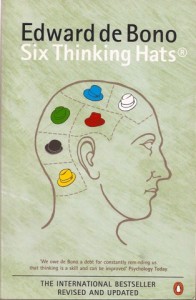The one-sentence summary
Discipline your business thinking, and the way in which you organise information.
- In 1985, Edward de Bono introduced his Six Thinking Hats, which has gone on to become one of the most successful approaches to business thinking in the last twenty years
- The Six Thinking Hats are:
~ White hat: facts, figures, information
~ Red hat: emotions, feelings, intuition, hunches
~ Black hat: cautious and careful (beware overuse!)
~ Yellow hat: speculative positive, benefit-led, constructive
~ Green hat: creative, lateral, provocative
~ Blue hat: control, structuring, organisation
WHAT’S GOOD ABOUT IT
- The technique forces people to adopt different attitudes and approaches to thinking, which removes them from bias and politics
- If followed correctly, the six hats provide an element of process to what can otherwise be a random brainstorm or ideas session
WHAT YOU HAVE TO WATCH
- In subsequent versions of the book, he noted with some dismay that the method was often used incorrectly, in that one individual often wore the same hat for the whole meeting
- In fact, everyone should wear each hat simultaneously to make best use of everyone’s intelligence and experience.
- As the novelty of using the process has worn off, and business techniques have developed, the system has attracted more criticism.
“It is not a complete solution.” Smart Leadership (Yudelowitz, Koch & Field, 2002)
- There may be two reasons for this:
1. Six frames of thinking are probably too many for most people to remember accurately. (The vast majority of business people are unable to name all six hat colours, let alone their designation and function).
2. It is hard for anyone to adopt one other mode of thinking, let alone six

